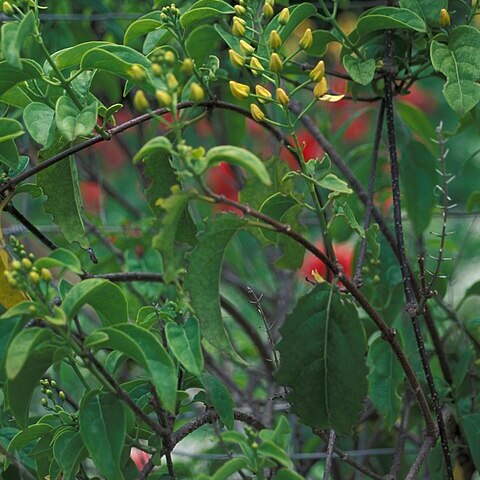Woody climbers, usually glabrous. Leaves opposite, entire, usually with 2 glands on margin of lamina near base (in T. africana glands near apex of petiole); stipules very small. Inflorescence racemose, terminal; pedicels articulated, 2-bracteolate. Flowers actinomorphic, bisexual. Sepals persistent, in some species with dorsal glands. Petals oblong, clawed, keeled, entire. Stamens with glabrous basifixed anthers; filaments of outer whorl longer and broader at base. Ovary globose; only 1 (very seldom 2) styles fully developed, terete. Fruit subligneous; lateral wing divided into 4–10 narrow stellately arranged lobes; median wing usually absent; samara sometimes with a dorsal crest. Seeds subglobose, with a short acumen formed by the radicle.
Woody lianas. Leaves opposite or whorled, stipulate; stipules connate with petiole; leaf blade entire, glandular. Racemes axillary or terminal; pedicels bracteate. Flowers 5-merous, bright yellow, bisexual, actinomorphic. Sepals with or without glands. Petals clawed. Stamens 10, unequal; filaments connate at base, articulate distally. Ovary 3-lobed, globose, often with abaxial appendages; style 1; stigma minute. Samaras 3, each 3-10-winged; wings conic, of unequal lengths, together thus star-shaped.
Leaves opposite, entire, usually with two glands on the margin of the lamina near the base (in T. africana glands near the apex of the petiole); stipules very small.
Fruit subligneous; lateral wing divided into 4–10 narrow stellately arranged lobes; median wing usually absent; samara sometimes with a dorsal crest.
Stamens with glabrous basifixed anthers; filaments of the outer whorl longer and broader at the base.
Inflorescence racemose, terminal; pedicels articulated, 2-bracteolate.
Ovary globose; only 1 (very seldom 2) styles fully developed, terete.
Seeds subglobose, with a short acumen formed by the radicle.
Sepals persistent, with dorsal glands in some species.
Petals oblong, unguiculate, carinate, entire.
Woody climbers, usually glabrous.
Flowers actinomorphic, bisexual.

